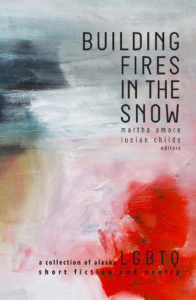By Nicholas Alexander Hayes

The city dominates the narratives of queer literature. Radclyffe Hall sends the protagonist of The Well of Loneliness to find themselves in London and finally Paris. Rita Mae Brown’s heroine of Rubyfruit Jungle winds her way to New York. Gore Vidal’s The City and The Pillar runs through many cities (notably New York) but also references that originary myth of a queer city, Sodom. The countryside can be seen but is often depicted as somehow melancholy and dangerous.
Martha Amore and Lucian Childs confront that narrative by collecting stories and poems from Alaskan writers. Whether these stories focus on life in a small village or one of the larger cities like Anchorage, they defy the typical homonormative story. There is a wide variety of narratives (stories and poems) presented in this anthology. Many of these capture the independent and rugged individualism of Queer Alaskans.
Leslie Kimiko Ward’s “Nest” tells the story of a woman who finds herself in an ersatz relationship with a woman who rents a room from her. Their relationship although in the rest of the US might seem a little queer works itself out as an expression of two women surviving the harshness of the winter. The relationship like many shows occasional points of bristling like when the protagonist won’t come immediately to deal with a hornet’s nest. Their struggle with the nest that has established itself in the attic provides an opportunity for the Queer protagonist to show her care for her straight but almost sexless roommate.
Also as expected, the juxtaposition of the individual against the vastness of the wilderness provides these writers an opportunity to capture beautiful meditations like Kate Partridge when she describes the human interactions in the midst of the vast wilderness. Partridge’s images resonate with many throughout the collection. It is perhaps a strong testimony of how the Alaskan environment shapes life in a way less evident in the Lower 48.
Despite elements that sometimes seem ubiquitous, Amore and Childs have selected works that reveal much diversity and intersectionality. Vivian Faith Prescott captures this in her selection of short and multimedia work. In “Can I Touch Your Chinese Hair?”, she explores the assumption others have in viewing her ethnicity, Sáami (Lapp), which doesn’t fit their assumptions about who she is. Her work reflects the complexity of navigating the complexities of ethnicity, regionality and personal interactions.
The standout author of this collection is M.C. Mohagani Magnetek. She offers the reader two stories with a frenetic, vital energies that the other works lack. Of course, the rest of the collection’s subtlety is beautiful. But Magnetek’s works stand out against the measured hand of the other writers. Magnetek shares much in common with the majority of these work. The central message that it is hard to be a woman in Alaska because the environment makes everyone’s life more challenging. Magnetek adds to this the voice that being a trans woman of color has its own special demands. She reveals the ways in which cis-hetero-normativity can’t contain the complexities of actual life. In the most cutting line of the anthology, Magnetek reveals a survival strategy for an often hostile world by saying, “Maybe a lie is what deserved to be told.”
Deception, subterfuge, and denial are not the only strategies available for the individual represented in this work. But underneath Magnetek’s powerful assertion is the strength that people need to survive in a world that is both socially and physically treacherous.
Building Fires in the Snow
Martha Amore and Lucian Childs, editors
University of Alaska Press
ISBN 978-1602233010









